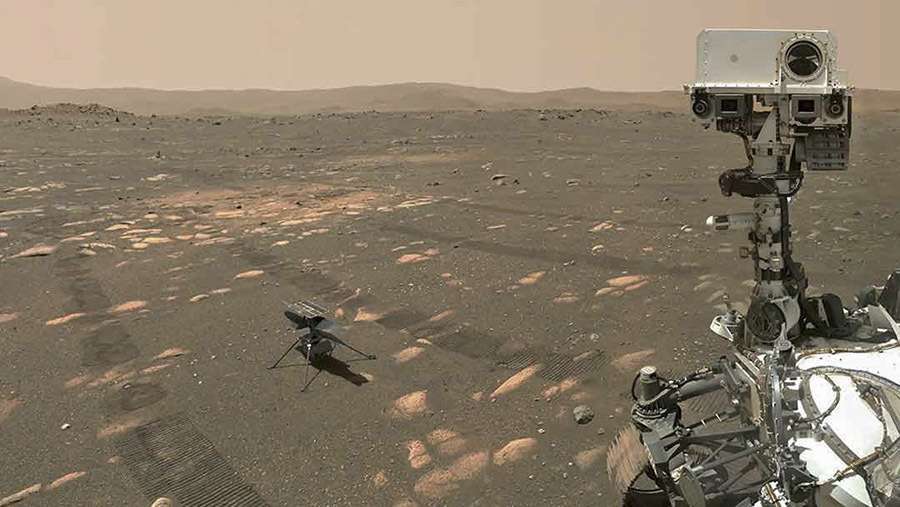Glory day for the US: historic first flight of an aircraft on Mars

The first flight of an aircraft into the airspace of an extraterrestrial object took place on the morning of 19 April and was a success. It was very basic, as befits a first fully autonomous high-risk operation on Mars, more than 280 million kilometres from Earth, adding to the already risky mission.
Engineers at the Jet Propulsion Laboratory (JPL) in Pasadena, California, have reported that early data confirm that the historic flight went as planned.

Ingenuity lifted off at 10:34 Spanish peninsular time, rose to a height of about 3 metres, hovered for a few seconds and then descended to the ground, all of which lasted 39.1 seconds. But the data did not arrive until three hours after the maiden flight at the large DSS-43 antenna in Canberra, Australia, which belongs to NASA's Deep Space Network.
The maiden flight and the transmission of data and images to the ground were carried out by the Perseverance rover, which is located 65 metres from the take-off site, at a point called the "Van Zyl lookout", from where its cameras and microphones kept an eye on the helicopter's first manoeuvres in the sky above the Red Planet. The observation site has been named after Jakob van Zyl, JPL's Director of Solar System Exploration, who passed away in August 2020.
Once Ingenuity has landed on the surface of Mars, it remains at the same landing site to recharge its six lithium-ion batteries to acquire the 350 to 500 watts of power it needs for its next 90-second flights.
 Batteries to withstand Martian cold and fly
Batteries to withstand Martian cold and flyThe operation is powered by small solar panels on top, which also allow the mini-helicopter to withstand the cold Martian nights, which can reach temperatures as low as minus 90 degrees Celsius (minus 90 degrees Fahrenheit). For Bob Balaram, chief engineer of the project at JPL, "both flying and enduring the Martian nights alone is a challenge that we have tried to overcome over the six years of the project's development".
Ingenuity does not carry any scientific instruments or experiments, but incorporates a laser altimeter and two cameras. One is black and white for navigation, which takes images while flying, can detect obstacles and has a resolution of 0.5 megapixels. The other is colour, has a resolution of 13 megapixels and is aimed at the horizon to send images of the environment back to Earth. On the recent maiden flight, the helicopter's software was programmed to take three colour and three black and white images.
What happens next? Future tests will attempt to fly longer distances and soar higher. However, everything is limited as Ingenuity has been developed to stay in the air for up to 90 seconds and travel up to 50 metres at a maximum height of 4.5 metres

On the second flight, it will climb to 5 metres and travel horizontally for a few metres, although the total duration will be 90 seconds, like the other planned flights. In the third flight, it will travel a maximum of 50 metres, and for the last two tests, it is planned that it can exceptionally travel a distance of up to 500 metres.
Each flight requires knowledge of the surrounding environmental conditions, in particular the direction of the wind and the temperature. This data is provided by the Spanish MEDA weather station on board the mother rover, which is one of the reasons why Perseverance remains a short distance from the take-off site.
The telemetry sent by Perseverance from the Red Planet includes a first image captured by one of Ingenuity's two cameras. It shows the helicopter's shadow on the Martian surface as it makes its ascent.

Weighing 1.8 kilos on Earth but reduced to 0.68 kilos on Mars due to the planet's lower gravity, Ingenuity incorporates a small piece of fabric from the Flyer, the plane built by the Orville and Wilbur Wright brothers that in 1903 flew 36.5 metres in 12 seconds.
This maiden flight was originally scheduled for 11 April, but had to be delayed due to an anomaly in the flight software during pre-flight testing on 8 April.

Ingenuity is a technology demonstration vector "so that NASA's next Mars missions will have an aircraft that brings a third dimension to Red Planet exploration," said Thomas Zurbuchen, the agency's associate administrator for science.
However, the missions already planned for Mars do not incorporate an aircraft. But NASA is already working on a helicopter larger than Ingenuity to participate in an exploration mission to Titan, a Saturn satellite with a very dense atmosphere. Called Dragonfly, it is scheduled to be launched into space in 2027.










